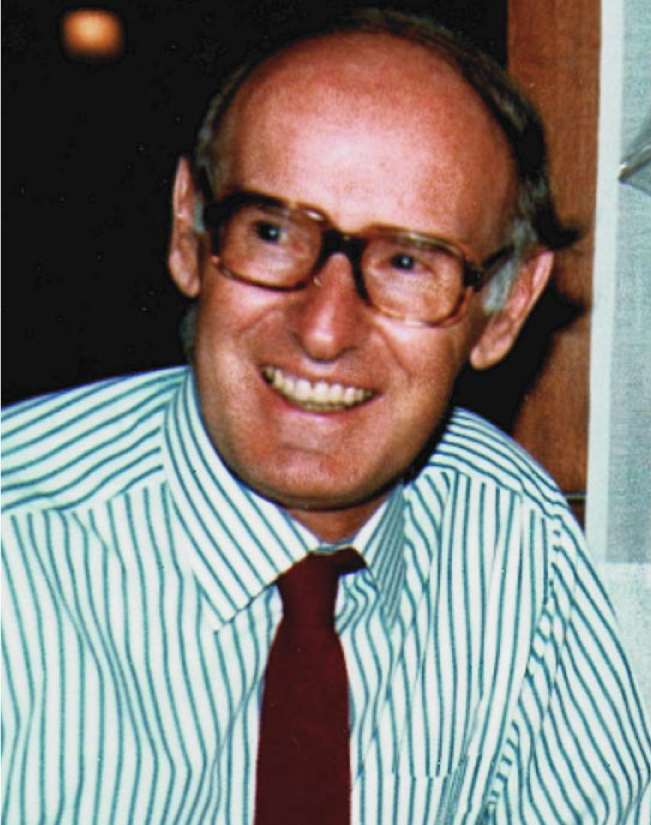Douglas Robert Ogston Morrison
DOI: 10.1063/1.1506763
When Douglas Morrison joined CERN in 1956 at the age of 27, the laboratory was a collection of wooden huts near Geneva airport in Switzerland. At the time of his death, from cancer, on 25 February 2001 in Geneva, CERN had become the world’s leading particle physics laboratory, with a complex of accelerators that stretched 10 kilometers from beneath the airport to the Jura mountains. During a lifetime dedicated to CERN and its ideals, Douglas’s greatest contribution to this expansion was to demonstrate that large, multinational, experimental collaborations can work successfully.
Born in Glasgow in the UK on 12 November 1929, Douglas qualified for university at age 15, but the university considered him too young to attend. He obtained a joint-honors BSc degree from the University of Glasgow in 1951, achieving first class in both mathematics and natural philosophy. He completed his PhD on cloud chamber experiments in 1957 under the supervision of Philip Dee.
Douglas’s first task at CERN, from 1956 to 1959, was helping to develop the then novel liquid-hydrogen bubble chamber. Bubbles formed along the trajectory of a charged elementary particle. Their collisions with protons in the liquid could be reconstructed by photographing these tracks in a magnetic field.
Thereafter, Douglas led the way in exploiting this technique by studying the interactions of separated beams of strongly interacting pions or kaons in those chambers. His philosophy was to study the highest energy beams available to probe more deeply into the interactions. In the 1960s and early 1970s, meson beams were limited to 16 GeV/c at CERN, so his quest took him to Brookhaven National Laboratory to exploit 23 GeV/c π +; to Serpukhov in the Soviet Union for 32 GeV/c K−; and to Fermilab for 100 GeV/c π − beams.
From the early 1960s, mass production scanning, measurement, and reconstruction techniques were developed at CERN, and a rich variety of physics was extracted. In 1962, Douglas was one of the first to demonstrate that high-energy collisions were peripheral. Data from his collaborations related the energy dependence of peripheral quasi-two-body reactions to the nature of the exchanged particle. Establishing the Gribov–Morrison spin-parity rule helped in the understanding of diffraction dissociation.
His extensive database of the highest energy interactions meant that leading theorists, such as Leon van Hove, director general of CERN, were keen for Douglas to try their latest ideas. As beam energy increased, multiparticle reactions became more important, and he conducted systematic studies with his collaborators. From 1973 to 1996, Douglas also contributed as secretary of the organizing committee of the Multiparticle Dynamics Conference.
Today, one particle experiment may involve more than 50 institutions and over 500 physicists. In the early 1960s, many physicists were skeptical about whether Douglas’s collaborations, involving 5–10 laboratories and 20–30 physicists, would work. That they worked so well is a tribute to his organizational skills and sociable personality. His great achievement was to allow many European university groups to participate as equals. In those days of a divided continent, the eastern European laboratories of Berlin, Warsaw, and Kraków particularly benefited. His contribution was recognized in 2000 with an honorary professorship from the Institute of Nuclear Physics in Kraków.
As electronic counter experiments began to accumulate better statistics and higher energy required colliding-beam machines, the days of the bubble chamber were numbered. However, in the late 1970s, intense neutrino beams became available at the CERN Super Proton Synchrotron. Douglas’s group formed an alliance with the heavy-liquid bubble chamber team that had discovered neutral currents, and the collaborators studied neutrino interactions in the Big European Bubble Chamber, which was filled with neon and hydrogen. Important contributions were made, including the first test of the newly emerging quantum chromodynamics, first measurements of hadronic charm production in beam-dump experiments, and some of the clearest observations of charm production in neutrino interactions.
In 1980, Douglas moved on to lead an even bigger, intercontinental collaboration of eight European, seven US, three USSR, and two Indian groups that studied neutrino interactions in the 15-foot chamber at Fermilab.
Throughout his career, but particularly in his position as an honorary staff member after retiring from CERN, Douglas’s intellectual curiosity and abundant energy led him to make important contributions in many other scientific areas. One example was his skepticism about cold fusion. In 1989, the use of electronic mail had just started to spread from particle physics to the wider scientific community. Douglas kept that world abreast of the latest cold-fusion developments with electronic updates that were the forerunners of today’s electronic bulletin boards and chat rooms.
Many of us have positive memories of summer collaboration meetings at CERN when the Morrison family hosted wine tastings. Guests brought wine from their home regions, and Douglas provided bottles from the very few wine-growing nations not represented in the collaborations. Labels were removed, and guests were invited to determine the country of origin of every bottle.
Another memory is of his tradition that, at 10 PM, group members who were still working were offered “tea.” This was quite an incentive to work late—the traditional English drink was fortified with “a wee dram” of the Scots’ national beverage!
It is typical of Douglas that, in the year before he died, he published seven scientific papers on five different subjects. These ranged from “CreutzfeldtJakob Disease” to “Energy in Europe.” One subject was “Survival and Cure Rates for Prostate Cancer.” He had undergone prostate treatment himself a few years previously. He faced this with his usual determination and good humor, and was full of energy to the last.
Douglas’s main legacy is the large number of European physicists and groups who learned the value of international collaboration under his leadership and who now play a full part in the worldwide experiments that dominate particle physics today.

Douglas Robert Ogston Morrison

More about the Authors
Keith W. J. Barnham. 1 Imperial College, London .
Gottfried Kellner. 2 CERN, Geneva, Switzerland .
